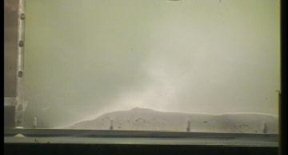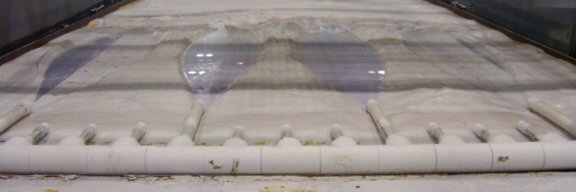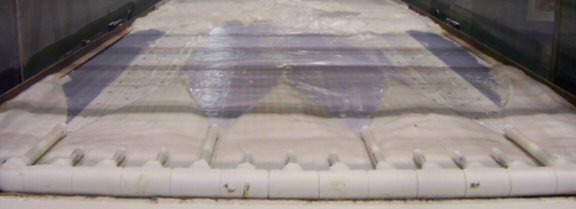Sediment Resuspension
Current research in this area is related to erosion caused by submerged turbulent wall jets. Different kinds of wall, plane, and circular jets are being studied. Granular and sewer sediment are being employed in the experiments. Sediment in all tests was resting on a fixed boundary. All jets were submerged. Tests were divided into three categories according to the type of jet and sediment used.
Test 1: Plane wall jet and granular sediment
The magnitude of the erosion caused by a plane turbulent wall jet on fine but non-cohesive sediment laying on a fixed boundary was studied in laboratory experiments and then compared to analytical predictions for this test. The results show a clear link between the final steady profile of the eroded front and the Froude number at the nozzle. It was also determined how the sediment erosion depends on the bottom shear stress exerted by the flow and how it decreases in the streamwise direction.
The erosion rate, or velocity of the front, decreases as the front moves away from the nozzle, because the flow velocity and bed shear stress decay away from the source of momentum, until it reaches a position where the shear stress is not able to erode the grains. It was observed that the angle of the front with respect to the bottom alternates between 45° to almost 90°, and this defines the front advancement pattern.
The bed shear stress exerted by the jet was computed first using the rate of change of streamwise momentum along the channel obtained from velocity profiles measurements without sediment on the bottom. It was found that in the sediment-clean part of the bed the velocity profiles correspond to those of the wall jet on fixed boundary.
After the jet is deflected by the sediment front, downstream of it, the characteristics of the flow change completely and resemble those of a gravity driven flow more than an inertia driven jet.
It was found that the position of the front along time and the front velocity collapse to non-dimensional units after defining a time beyond which the front remains almost motionless.
ADVs were used to measure velocity profiles at different points.
Media
The pictures below show the evolution with time of one experiment in which it is possible see the oscillating pattern of the front above mentioned.
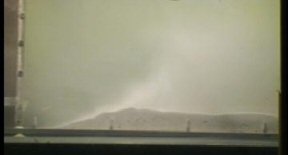 Test 1 |
|
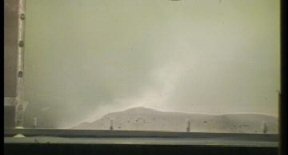 Test 3 |
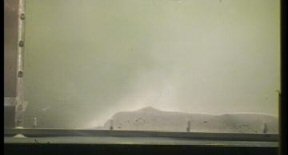 Test 4 |
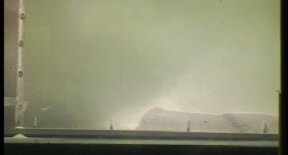 Test 5 |
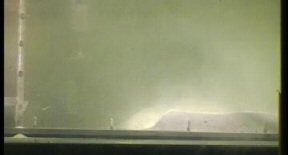 Test 6 |
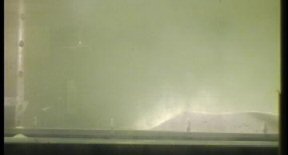 Test 7 |
 Test 8 |
Test 2: Plane wall jet and sewer sediment
The magnitude of the erosion caused by a plane turbulent wall jet on slightly cohesive sediment laying on a fixed boundary is being studied with the help of laboratory experiments. The results show a connection between the final steady state profile of the eroded front and the parameter l = rUo2 closely associated with the bottom shear stress created by the flow.
The erosion rate, or velocity of the front, decreases with time as the front moves away from the jet nozzle, because the flow velocity and bed shear stress decay away from the source of momentum. Eventually an asymptotic position is reached and the shear stress is not longer able to erode the sediment.
It was found that the position of the front along time and the front velocity collapse to dimensionless curves if referred to time and length scales corresponding to the asymptotic state.
Media
The pictures below show a time series of one of the experiments.
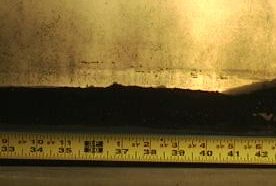 Initial condition |
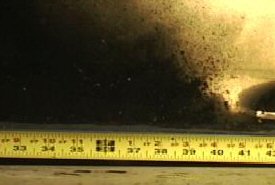 104 seconds |
 162 seconds |
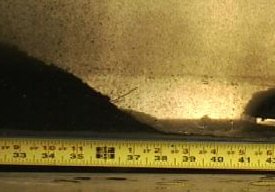 272 seconds |
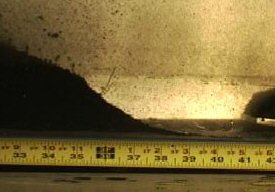 392 seconds |
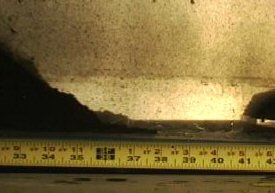 515 seconds |
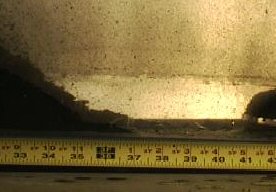 695 seconds |
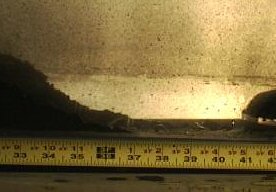 1,290 seconds (final condition) |
Test 3: Circular wall jet and granular sediment
The magnitude of the erosion caused by submerged multiple circular turbulent wall jets on fine non-cohesive sediment laying on a fixed boundary is being studied with the help of laboratory experiments. Different combinations of jet diameter, jet separation and ratio between the sediment thickness and the jet diameter were executed. Results show a connection between the position of the steady state profile and the densimetric particle Froude number given by the velocity at the nozzle and the effective diameter of the sediment. Evolution of scour with time and comparison with Jenkins’s equation are also developed. Eventually a design criterion is being proposed in order to estimate the characteristics of the jet array needed to clean a given length of sediment.
Media
Pictures show jet array and steady state profiles for some experiments after dewatering.
